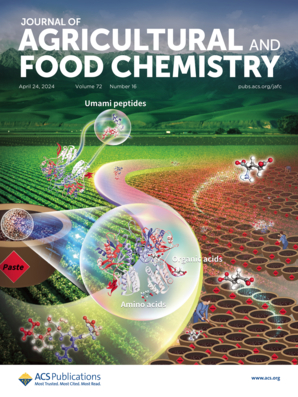Regulation of Glucose Uptake Level by Black Corn-Derived Anthocyanins at the Small Intestinal α-Glucosidases and Different Types of Glucose Transporters
IF 5.7
1区 农林科学
Q1 AGRICULTURE, MULTIDISCIPLINARY
引用次数: 0
Abstract
Attenuating the postprandial glycemic spike is crucial for managing blood-glucose homeostasis and mitigating chronic diseases. The structural and functional properties of anthocyanins from black corn (Zea mays L.), and their role in modulating glucose uptake by regulating digestive enzymes and glucose transporters via their multiple hydroxyl groups, were investigated. Among the purified anthocyanins with significant antioxidant activity in ABTS+ and DPPH assays, cyanidin, pelargonidin, and peonidin were dominant, as indicated by HPLC-MS analysis. Based on the IC50 values, black corn anthocyanins effectively inhibited mammalian α-glucosidases, reducing glucose generation from α-1,4-linked glycemic carbohydrates. In a Caco-2 cell model, anthocyanins reduced the glucose-transport efficiency and downregulated the mRNA expression of key glucose-transporter-related genes. ICR male mice orally administered the purified anthocyanins showed significantly attenuated glycemic responses to α-1,4-linked carbohydrates (p < 0.05). Thus, black corn anthocyanins exhibit promising properties as functional ingredients for the regulation of postprandial blood glucose levels.

黑玉米花青素对小肠α-葡萄糖苷酶和不同类型葡萄糖转运体葡萄糖摄取水平的调节
降低餐后血糖峰值对于控制血糖稳态和减轻慢性疾病至关重要。研究了黑玉米(Zea mays L.)花青素的结构和功能特性,以及它们通过多个羟基调节消化酶和葡萄糖转运体在葡萄糖摄取中的作用。高效液相色谱-质谱分析表明,在ABTS+和DPPH实验中纯化的具有显著抗氧化活性的花青素中,花青素、天竺花苷和芍药苷占主导地位。根据IC50值,黑玉米花青素有效抑制哺乳动物α-葡萄糖苷酶,减少α-1,4链糖碳水化合物的葡萄糖生成。在Caco-2细胞模型中,花青素降低葡萄糖转运效率,下调葡萄糖转运蛋白相关关键基因的mRNA表达。口服纯化花青素的ICR雄性小鼠对α-1,4链碳水化合物的血糖反应显著降低(p <;0.05)。因此,作为调节餐后血糖水平的功能性成分,黑玉米花青素表现出了良好的特性。
本文章由计算机程序翻译,如有差异,请以英文原文为准。
求助全文
约1分钟内获得全文
求助全文
来源期刊
CiteScore
9.90
自引率
8.20%
发文量
1375
审稿时长
2.3 months
期刊介绍:
The Journal of Agricultural and Food Chemistry publishes high-quality, cutting edge original research representing complete studies and research advances dealing with the chemistry and biochemistry of agriculture and food. The Journal also encourages papers with chemistry and/or biochemistry as a major component combined with biological/sensory/nutritional/toxicological evaluation related to agriculture and/or food.

 求助内容:
求助内容: 应助结果提醒方式:
应助结果提醒方式:


